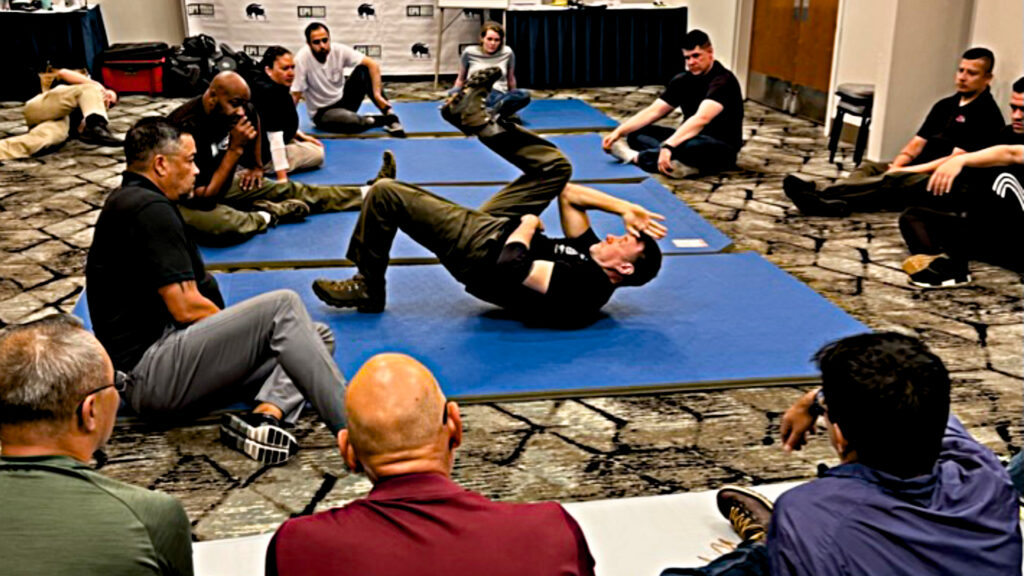
Recently, I’ve received several questions about the ground section of the C-Tac Combat Blueprint, specifically about how we divide it into multiple parts and the reasoning behind this approach. Understanding the structure of this section is essential for those aiming to develop a comprehensive and practical skill set in ground combat.
Why Break It Down?
The methodology behind segmenting the ground section stems from an old-school educational philosophy: the best way to master a complex skill or subject is to deconstruct it into its simplest components. This process allows students to gain a deeper understanding of each individual element before synthesizing them into a cohesive system.
Breaking ground combat into smaller, digestible pieces ensures practitioners develop a solid foundation in each study area. This structured approach promotes mastery and helps students identify and address weaknesses in specific aspects of their training.
Breaking Down the Parts
In our system, we typically divide the ground section into five key areas: grappling, anti-grappling, ground fighting, dog boxing, and grounded weapons fighting. Each area addresses specific skills and scenarios, providing a comprehensive approach to ground-based combat.
A New Dimension: Grappling vs. EDC Grappling
Over the past decade, I’ve found that the grappling component has evolved to include a second, distinct category: EDC (Everyday Carry) Grappling. This shift began about 17 years ago when I introduced a training gun and knife kit into my grappling sessions. The objective was simple—if my partner could successfully deploy the weapon during the roll, it was treated as a “submission.”
This experiment revealed something profound: I had to re-evaluate everything. The foundational mechanics, techniques, principles and tactics I had learned in traditional grappling no longer applied in the same way when weapons wereinvolved. It wasn’t just about adding a weapon to the mix—it fundamentally changed how I approached every aspect of grappling.
I had to return to the first techniques I learned and adapt them to accommodate the presence of weapons. This process didn’t just tweak the existing curriculum; it led to the creation of an entirely new one—EDC Grappling. This specialized subset of grappling focuses on integrating weapons awareness, retention, and deployment into traditional grappling scenarios.
The Need for a Separate Curriculum
EDC Grappling has grown into such a distinct body of knowledge that it now stands on its own as part of the grappling category. While traditional grappling remains focused on positional control, escapes, and submissions, EDC Grappling incorporates the complexities of weaponized encounters, including:
• Retaining your weapon while under pressure.
• Defending against an opponent attempting to use a weapon.
• Using the presence of weapons to enhance your tactical options.
By separating these two areas, we can focus on each with greater precision, ensuring that students develop both the foundational skills of grappling and the specialized tactics needed for real-world, weaponized scenarios. This evolution in training reflects the dynamic nature of self-defense and the importance of continually adapting to real-world challenges. So now the ground section list of the Blueprint looks like this:
- Grappling & EDC Grappling
- Counter or Anti-Grappling
- Ground Fighting
- Dog Boxing
- Grounded Weapons Fighting
Grappling & EDC Grappling
Traditional grappling is widely available and well-documented. A quick Google or YouTube search will yield countless resources for those unfamiliar with the discipline. However, EDC Grappling—grappling with a focus on weapons integration—is an entirely different approach. This method required me to revisit and rewire many of the fundamental principles I had been taught in traditional grappling.
The Shift from “Flat” to “Earned Flat”
In traditional grappling, I had become comfortable working from flat on my back, a position commonly accepted as part of the game. However, in a weaponized scenario, this approach had to be abandoned. Giving up “flat” was no longer an option; it created vulnerabilities that could be exploited in life-or-death situations.
Instead, I adopted the mantra, “Make them earn flat.” This mindset shift emphasized the importance of staying active, dynamic, and aligned in defensive positions. Rather than conceding the position, my focus became forcing the opponent to work for every advantage—a critical adjustment in weaponized encounters.
Surviving Non-Dominant Positions
Another essential adaptation was learning to survive and defend effectively from non-dominant positions. This required mastering the intelligent alignment and mechanics of the torso. In traditional grappling, both hands are often free to engage and defend. However, in EDC Grappling, one hand is frequently dedicated to securing or protecting a weapon system.
This limitation meant I had to develop techniques that allowed me to grapple with one arm while maintaining control over my weapon. The mechanics of balance, posture, and leverage became even more critical as I needed to maximize efficiency with limited resources.
Redesigning Fundamental Techniques
Through this process, I discovered that many of the techniques I had relied on in traditional grappling unintentionally exposed my weapon system to the opponent. Worse, some techniques even served the weapon directly to them, placing it in their reach at the most inopportune moments.
This realization led to a complete overhaul of my approach. Techniques had to be reworked, redesigned, or abandoned entirely. The new system required not just adapting movements but also understanding the broader tactical implications of every position and transition.
Rewiring Habits Built Over Years
One of the most challenging aspects of this transformation was undoing habits built through years of repetition. The techniques I had practiced hundreds of thousands of times were deeply ingrained in my nervous system. While they wereeffective for sport grappling, they posed significant risks in a real-world, weaponized scenario.
Breaking these habits and adopting new methods took time and deliberate effort. It required retraining my body and mind to approach grappling through the lens of survival and tactical advantage. The ultimate goal was to ensure that every movement protected myself and controlled the encounter rather than inadvertently benefiting the attacker.
Why EDC Grappling Matters
EDC Grappling is not just a variation of traditional grappling; it’s a reimagining of the art with a focus on real-world application. It incorporates the realities of weapons and the dangers they introduce to a close-quarters encounter. For anyone serious about self-defense, understanding and training in EDC Grappling is essential. It bridges the gap between grappling as a sport and grappling as a survival tool, ensuring you’re prepared for the unpredictable nature of real-world combat.
Counter or Anti-Grappling
The next division of the ground section focuses on Counter or Anti-Grappling, a method that examines the core principles of grappling to use its common reactions against it. Anti-grappling involves studying grappling as a whole to identify and exploit the key elements that most grapplers rely on.
Through observation and practice, we found that most grapplers depend on three fundamental components:
1. Creating Space: Space is critical for initiating movement and setting up techniques.
2. Generating Movement: Movement allows grapplers to transition, escape, or improve their position.
3. Building Frames: Frames are structural barriers used to keep opponents at a distance, enabling better mechanics and positional control.
A counter-grappler views these essential elements not as obstacles but as opportunities to disrupt and neutralize their opponent’s game. By anticipating and exploiting the creation of space, movement patterns, or the use of frames, a counter-grappler turns these foundational principles against their opponent.
This shift in perspective was a game-changer for me. When I began studying these tactics, it completely altered how I approached grappling. I realized that to defend against counter-grappling strategies, I needed to revisit and refine my ownfundamentals. This led me back to the drawing board, where I started adapting my techniques to account for someone actively countering my actions.
Counter or Anti-Grappling isn’t just a defensive strategy—it’s a proactive approach that challenges traditional grappling norms and demands a higher level of awareness and adaptability. It’s a crucial area of study for anyone serious about understanding the full spectrum of ground combat.
Ground Fighting
If I were to compare ground fighting to any familiar context, the closest parallel would be mixed martial arts (MMA). The primary objective of the ground fighting subsystem is to develop the ability to deliver destructive force from any position, whether offensive or defensive. Striking becomes the dominant tool in this environment, especially in situations wheretraditional grappling techniques may not be ideal.
In a grappling exchange, there are only a few mechanical angles that allow you to control an opponent effectively while simultaneously delivering impactful strikes. Ground fighting emphasizes maximizing these opportunities, particularly from defensive positions where maintaining control is critical.
Another key component of ground fighting is adapting the striking game to different scenarios. For example:
• Striking from the ground against a standing opponent.
• Engaging a downed opponent when standing.
• Breaking conventional grappling rules to prioritize effective striking over positional control.
Additionally, ground fighting takes into account the possibility of multiple opponents, an aspect often overlooked in traditional grappling. Real-world altercations are rarely fair or one-on-one. You may need to contend with a second, potentially aggravated attacker or “wingman,” which drastically changes the dynamics of the fight. In such cases, relying on grappling could leave you vulnerable, making an adaptable striking game crucial for survival.
Ground fighting is not just about technical proficiency—it’s about understanding when and how to apply striking to complement or replace grappling in chaotic, unpredictable situations. It prepares you to face real-world encounters with versatility and confidence.
Dog Boxing
The term “Dog Boxing” is borrowed from Chinese Boxing and Kung Fu, but in our system, it refers to out-of-position fighting. Many martial arts systems focus heavily on training techniques from specific, ideal positions—most often standing in an open space with room to maneuver. From these positions, practitioners learn proper body mechanics to generate striking force. However, they often neglect scenarios where they are forced into unfamiliar or less advantageous positions.
In a real fight, if someone grabs a martial artist and puts them in an awkward position—perhaps pinning them or applying chaotic force—most practitioners instinctively struggle to return to their “preferred” position before attempting to execute techniques. This hesitation creates a critical gap, leaving them vulnerable during the struggle.
Dog Boxing aims to eliminate that gap.
A dog boxer trains specifically to fight effectively from out-of-position scenarios, ensuring they are comfortable and capable in situations where traditional techniques might falter. Examples of out-of-position scenarios include:
• Fighting from a seated or kneeling position.
• Defending while pinned against a wall.
• Striking or defending from a laying position.
One of the initial areas of focus in Dog Boxing is fighting while pinned against a wall. This teaches practitioners to generate force in confined spaces and respond effectively under pressure. A skilled dog boxer understands the mechanics of all these positions, so they don’t experience discomfort or hesitation when placed there.
Instead of struggling to regain a more familiar position, dog boxers are trained to use the position they’re in to their advantage. By practicing the mechanics and force generation of each scenario, they develop confidence and adaptability, enabling them to respond immediately and effectively.
Dog Boxing equips practitioners with the ability to handle the chaos of real-world fights, ensuring that being out of position is never a disadvantage but rather an opportunity to turn the tables.
Grounded Weapons Fighting
In modern training, a common approach to addressing weapons in a grappling environment is simply adding training weapons—such as knives or guns—into standard grappling scenarios. While this is a good baseline to start with and can shift your perspective, it often lacks the depth and specificity needed for real-world application. Simply introducingweapons without adjusting tactics doesn’t account for the unique challenges and dynamics of incorporating weapon systems into close-quarters combat.
In a standing fight involving weapons, several key principles come into play:
1. Creating Space: Distance is a critical factor for safety. The more space you can create between yourself and an armed opponent, the safer you are.
2. Gaining a Superior Angle: Positioning yourself at an advantageous angle, such as stepping off the line of attack, improves your ability to control the encounter. For example, in a gunfight, sidestepping to “get off the X” is a common tactic to gain a better angle for counterattacking.
3. Controlling Timing: In any martial arts encounter, timing is crucial. You can be on time, ahead of time, or behind time. In a weaponized scenario, being ahead of time—whether by preempting an attack or reacting faster than your opponent—can be the difference between success and failure.
These principles, however, become far more difficult to achieve when you’re in a grappling situation. The confined space and physical entanglement of grappling can neutralize many of the advantages you would typically rely on in a standing fight.
This is where Grounded Weapons Fighting comes in. Rather than simply adding training weapons to the grappling environment, this system is built on a methodology designed to adapt these key principles—space, angle, and timing—into close-quarters combat. The focus is on finding ways to “cheat” and gain an advantage despite the inherent constraints of grappling.
Grounded Weapons Fighting is fundamentally different from just throwing weapons into a grappling match. It’s about developing a system that integrates the unique challenges and opportunities of dealing with weapons while grounded. By understanding how to use space, manipulate angles, and control timing in a confined environment, practitioners can create strategies that allow them to survive and win—even when the odds are stacked against them.
This specialized approach ensures that grappling with weapons isn’t just an add-on to your training but a fully developed and practical skill set for real-world encounters.
The C-Tac Combat Blueprint Ground Section
The ground section of the C-Tac Combat Blueprint offers a comprehensive and methodical approach to developing skills for real-world combat. By breaking down the complexities of ground fighting into distinct categories—Grappling & EDC Grappling, Counter or Anti-Grappling, Ground Fighting, Dog Boxing, and Grounded Weapons Fighting—practitioners can train with precision, depth, and adaptability.
This segmentation is not merely about learning techniques; it’s about understanding and mastering the underlying principles of each component. Whether it’s the tactical adjustments required in EDC Grappling, the strategic mindset of Counter-Grappling, or the situational adaptability of Dog Boxing and Grounded Weapons Fighting, each area addresses unique challenges that are often overlooked in conventional training.
Ultimately, this approach ensures that students are not just prepared for the controlled environment of a training mat butfor the chaotic and unpredictable nature of real-world encounters. The C-Tac Combat Blueprint empowers practitioners to handle adversity with confidence, adaptability, and efficiency—qualities that are essential in any self-defense scenario.
As you explore and integrate these concepts into your training, remember that self-defense is a constantly evolving practice. By continuously refining your skills and mindset, you not only prepare for potential threats but also develop a greater sense of discipline, awareness, and mastery in every aspect of life.
The path is challenging, but the rewards are immense. Keep training, stay adaptable, and always be prepared.
Shift Your Perspective, Take Action, & Lead Yourself To Greatness
~ Sifu Alan

Alan Baker is renowned for his dual expertise in crafting tailored Defensive Tactics Programs and high-performance coaching. Catering specifically to law enforcement agencies, military organizations, and security firms, Alan designs training regimens that emphasize practical techniques, real-world adaptability, and scenario-based training. His approach enhances the capabilities and readiness of personnel in intense situations. His clients include the Executive Protection Institute, Vehicle Dynamics Institute, The Warrior Poet Society, ALIVE Active Shooter Training, Retired Navy SEAL Jason Redman, Tactical 21, and many others. Sifu Alan is the creator of the C-Tac® (Civilian Tactical Training Association) System and
Protection Response Tactics (PRT), two highly regarded training systems that emphasize realistic, adaptive techniques for both civilians and professionals in high-risk fields. Explore Alan’s tailored programs here. Sifu Alan travels across the U.S., teaching camps and seminars on the programs he’s developed and the multiple martial arts he has studied for nearly five decades.
Beyond mere tactics, Alan stands out as the paramount “Self Leadership” coach, adept at unlocking the vast potential within individuals. With a deep passion for mentoring professionals, entrepreneurs, and those on personal growth odysseys, he focuses on nurturing a mindset of excellence. Alan’s coaching hinges on practical strategies that bolster mental resilience, focus, and drive. Teaming up with Alan means embarking on a transformative path where mental barriers are dismantled, inherent strengths come to the fore, and your goals become within clear sight. His profound insights enhance performance and sculpt a mindset tailored for triumphant success.
To delve deeper into Alan’s mindset philosophy, peruse his enlightening collection of books. If you’re ready to amplify your journey under Alan’s tutelage, connect through his official website.
